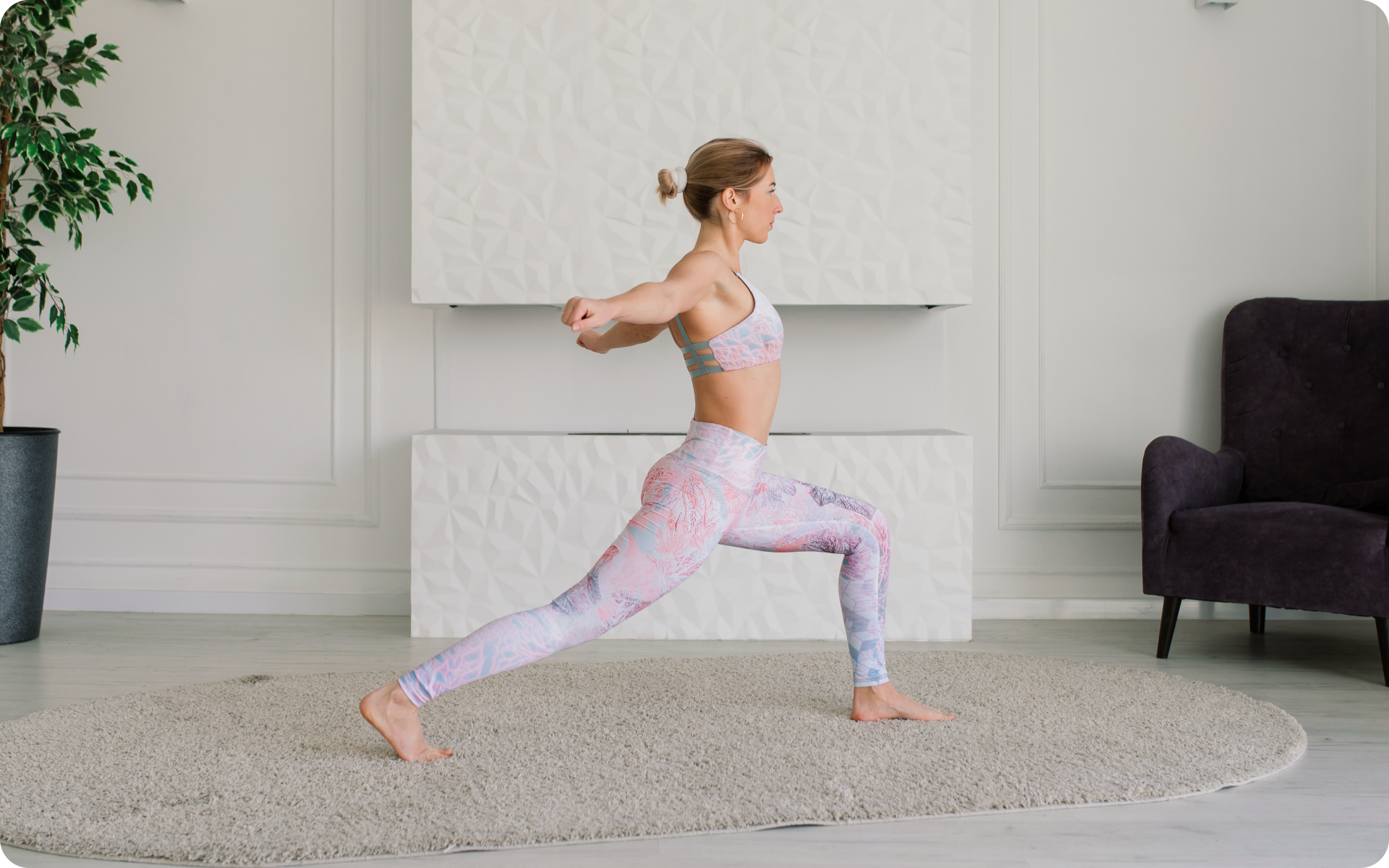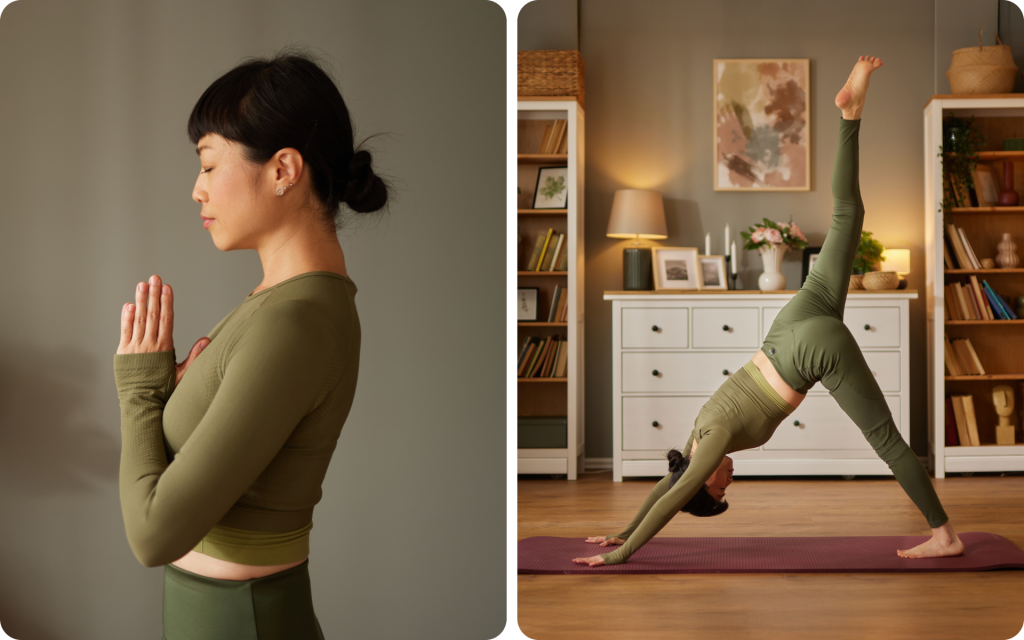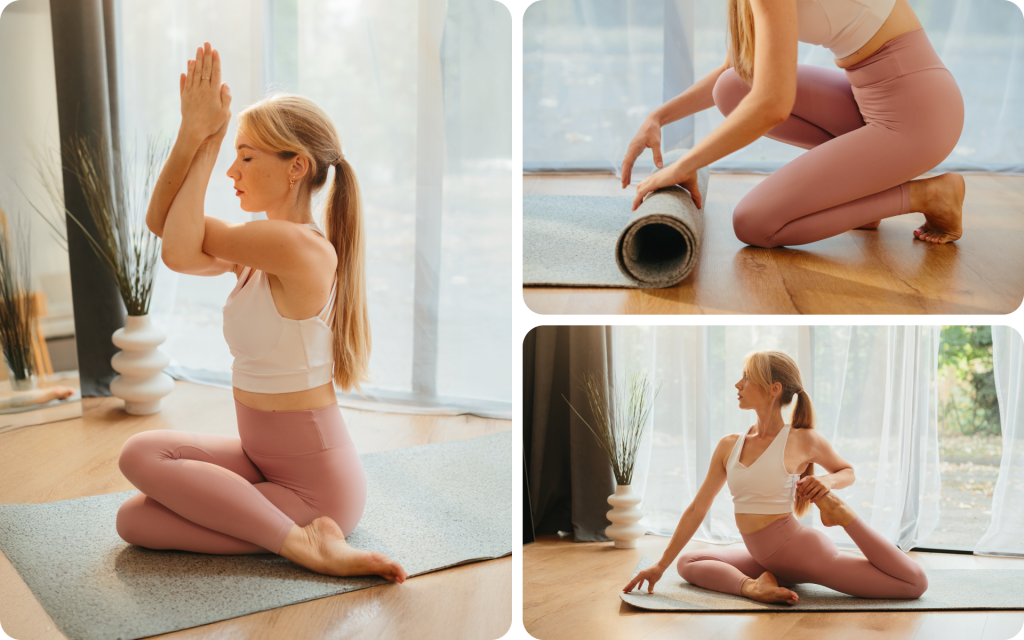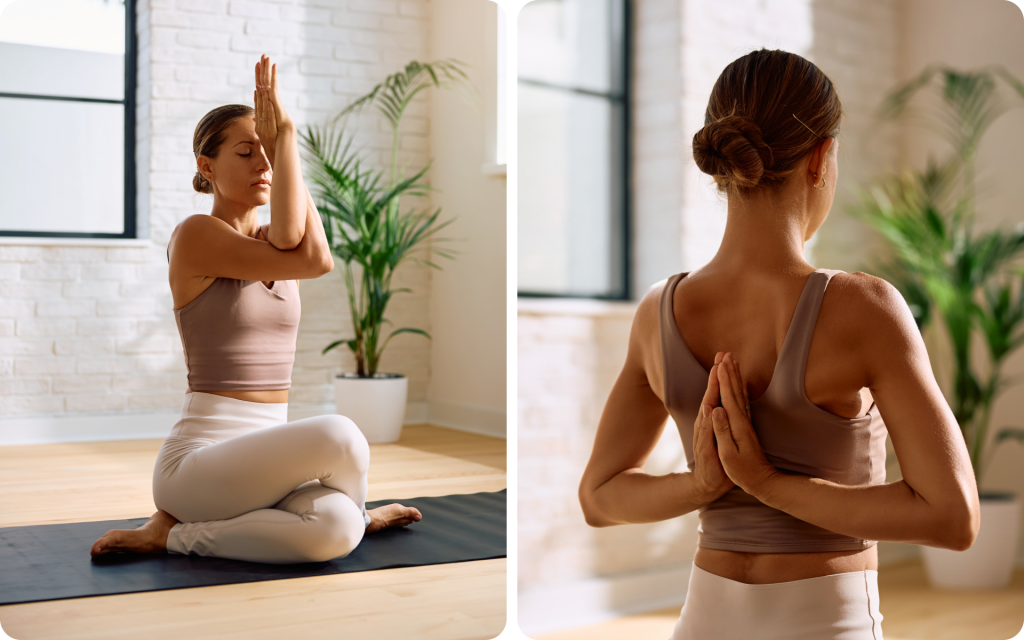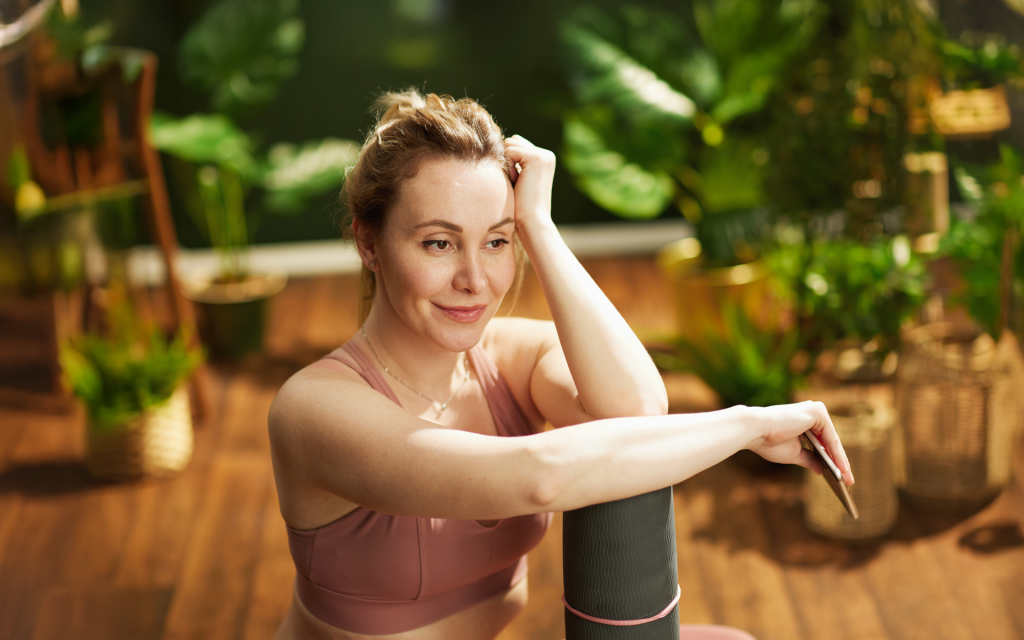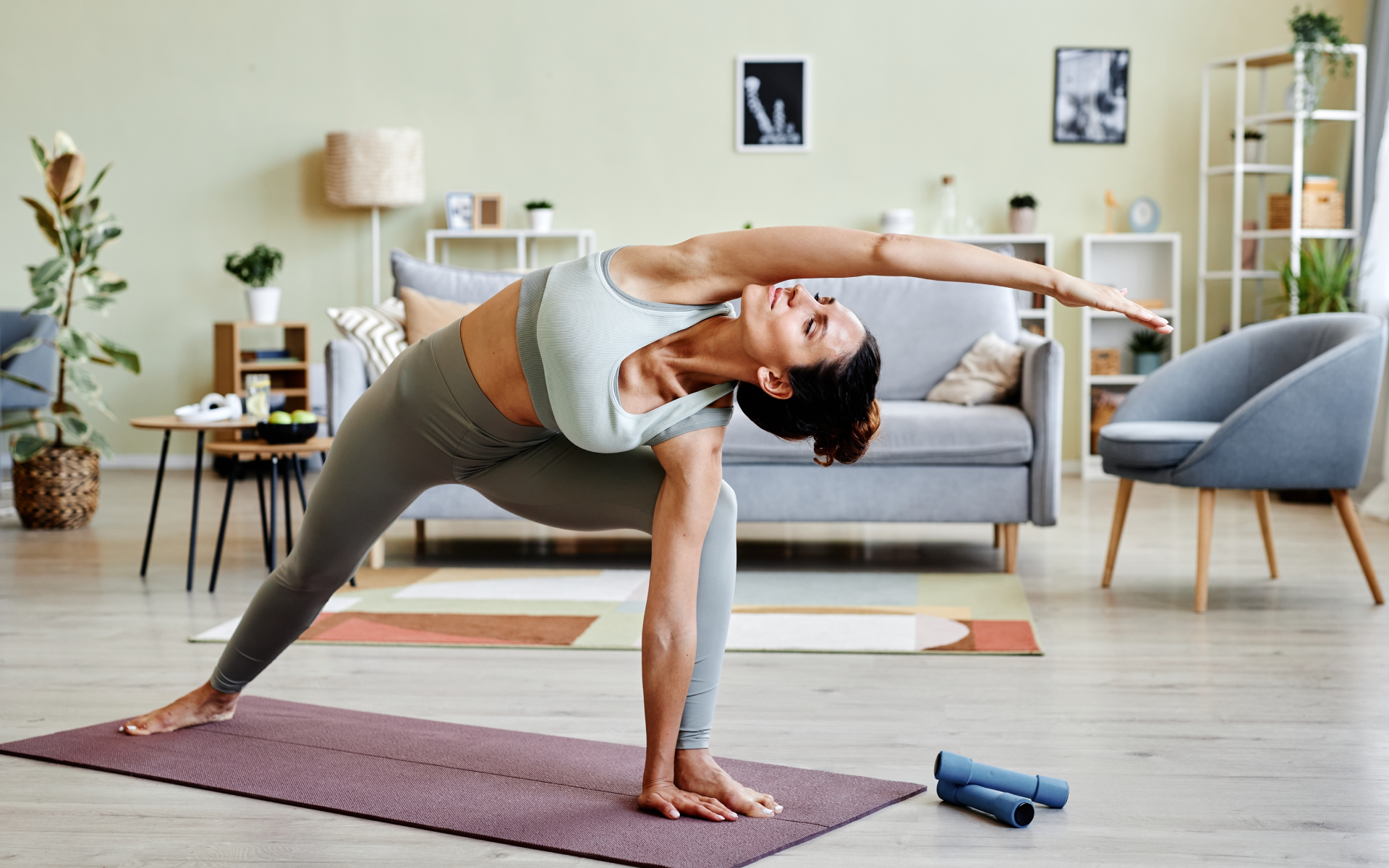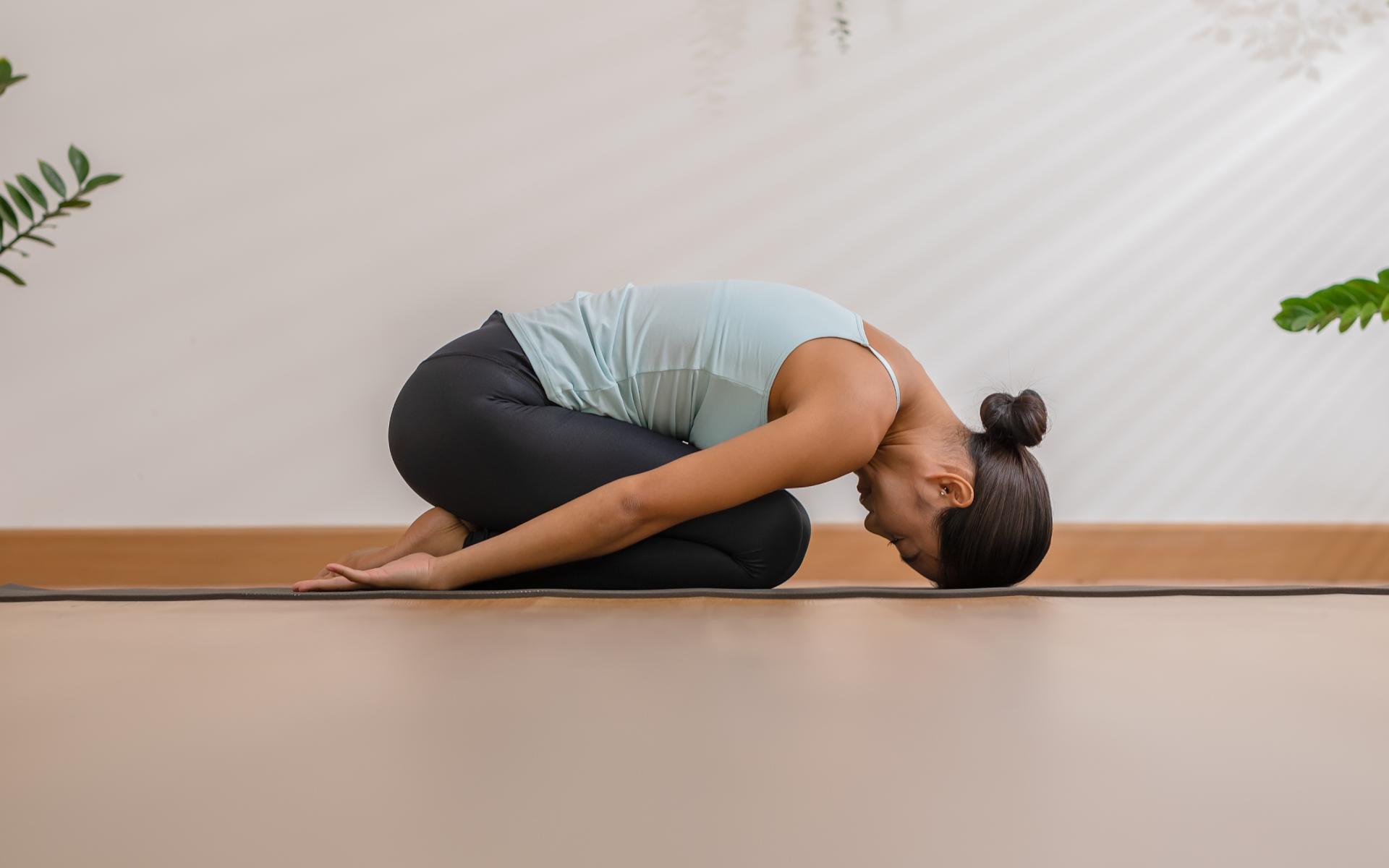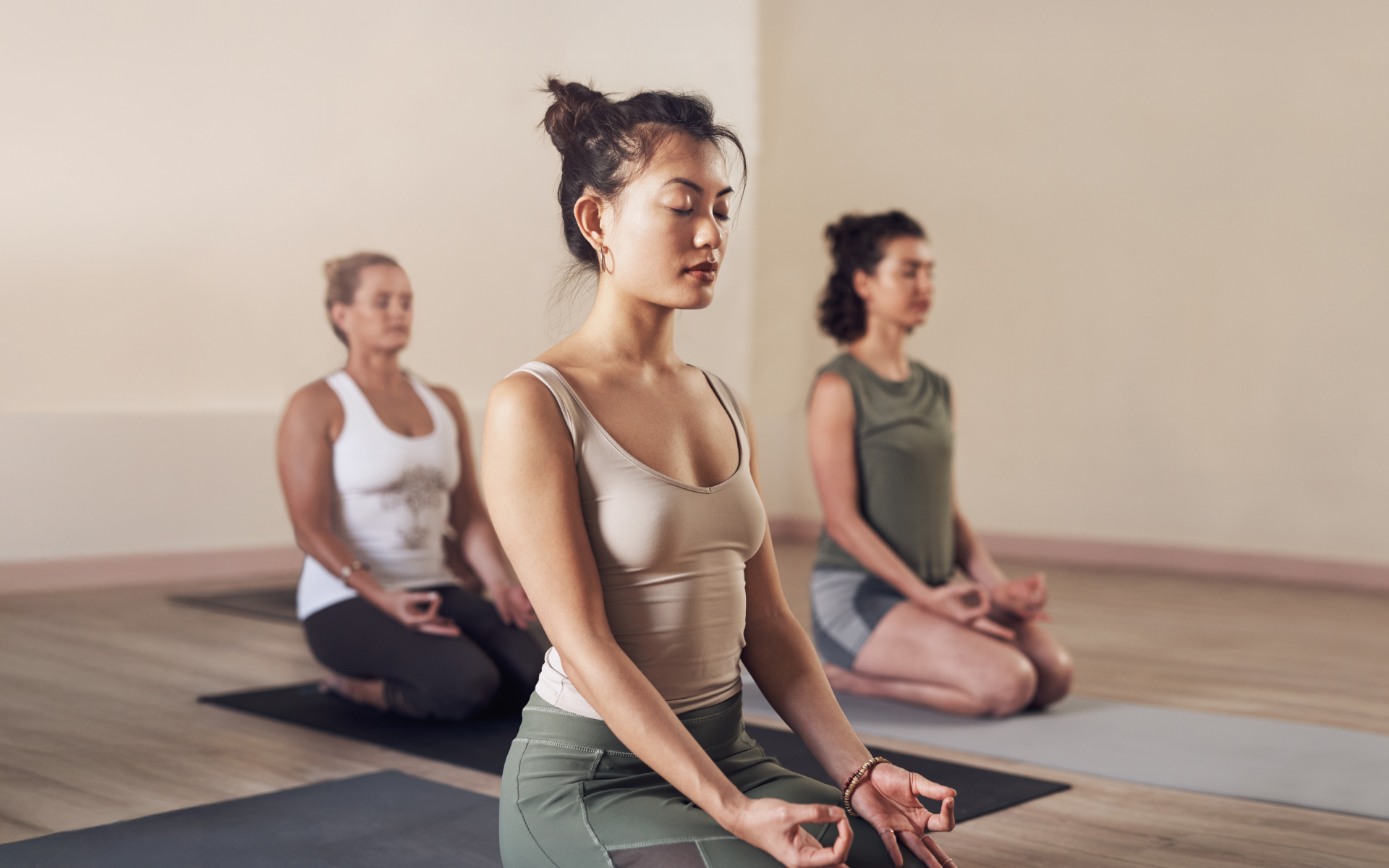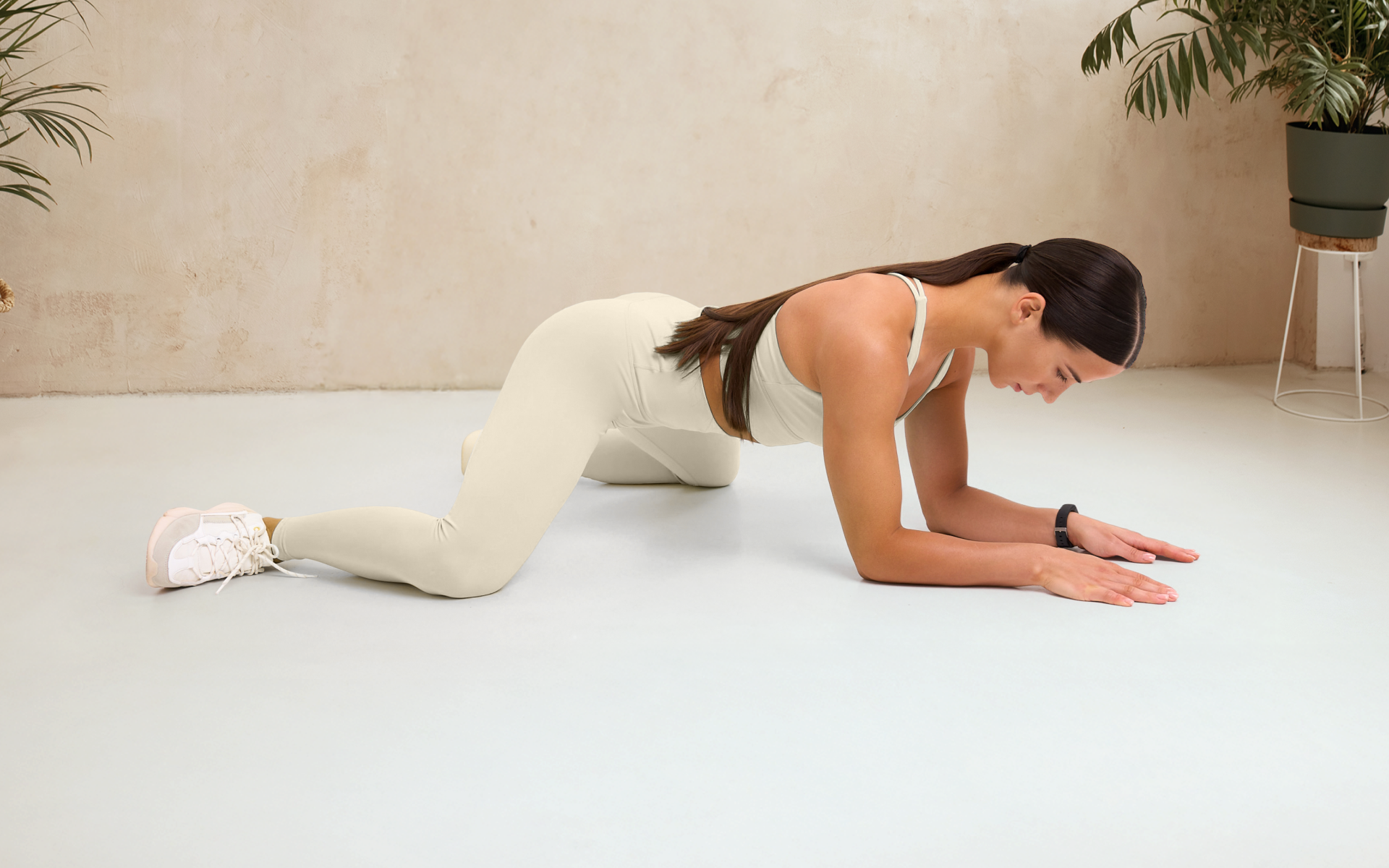When life seems to be pulling you in every direction with seemingly endless to-do lists and responsibilities, it’s essential to slow down and reconnect with your mind and body.
A somatic yoga workout plan can offer a gentle, supportive way to do just that. Unlike traditional workouts that often focus on appearance or fitness goals, somatic yoga helps you tune into internal sensations during movement (1). This approach can support both mental and physical well-being by strengthening the mind-body connection, potentially enabling you to better respond to your body’s needs and move through life with greater balance, ease, and resilience (2).
This article will look at what a somatic yoga workout plan is, its benefits, and 5 somatic yoga exercises for beginners to get started with.
What Is a Somatic Yoga Workout Plan?
Somatic yoga is rooted in the broader concept of somatics, which includes a wide range of body-based practices that are focused on internal awareness and the connection between the mind and body (1).
Somatics first gained recognition through the work of experts such as Thomas Hanna, who believed that many of our physical and emotional challenges stem from a sense of disconnection in the body (3). Since then, it has evolved into a variety of body-based practices – including somatic yoga – that are designed to address the mind-body connection by helping you become more in tune with internal sensations during movement.
Essentially, a somatic yoga workout plan combines gentle poses (known as asanas) with heightened and intentional body awareness (4, 5). Instead of focusing on fitness or appearance-based goals, the goal here is to pay attention to what’s happening inside your body as you move. This may mean noticing physical sensations, areas of tension, shifts in breathing patterns, or even emotional responses that arise during movement.
When it comes to body awareness, there are three key areas that somatic practices often focus on (6):
- Interoception: Noticing what’s happening inside your body, such as your breath, heartbeat, hunger cues, or muscle tension.
- Exteroception: Paying close attention to your external environment, sensing external factors such as noise, temperature, or light.
- Proprioception: Understanding where your body is in space, including its movement and balance, even without looking.
Somatic yoga also supports nervous system regulation by helping you shift out of the “fight-or-flight” stress mode and into a more relaxed “rest-and-digest” state (7). When practiced regularly through a somatic yoga workout plan, it can help release tension, calm the mind, and bring a deeper sense of balance to your daily life.
Do Somatic Workout Plans Work?
If you’re wondering whether a somatic yoga workout plan actually works, you’re not alone. While early research is promising for supporting mental and physical well-being, particularly by reducing stress and improving body awareness (8), more studies are required to fully confirm their full range of benefits for all groups of people.
As everyone responds differently, it’s a good idea to check in with your healthcare provider before you start a somatic yoga plan. They can help you figure out if somatic yoga is a good fit for your goals while also offering personalized support along the way.
Intense sweat sessions, working weight loss tips, lip-smacking recipes come in one package with the BetterMe: Health Coaching app—all at your fingertips, start transforming your life now!
Benefits of Somatic Yoga
Somatic yoga can offer a range of benefits to support your overall well-being, but you should keep in mind that the effects often vary from person to person. Some people may notice changes almost immediately, while it may take some more time for others.
Remember that progress isn’t linear and this is perfectly normal. With somatic practices, the goal is to stay present with your body and avoid comparing your journey to others.
Some common benefits of somatic yoga include:
- Increased mind-body awareness: By tuning into your body’s sensations during movement, you can strengthen the connection between your mind and body (9).
- Reduced stress: Somatic yoga helps regulate the nervous system, calming both the mind and body, which helps promote relaxation and reduce stress (9, 11).
- Decreased chronic pain: Somatic practices may help address emotions and ineffective movement patterns stored in the body that could contribute to chronic pain or muscle tension (10).
- Enhanced trauma recovery: Releasing emotional patterns through movement may help with trauma recovery, but you should always seek the guidance of a mental health professional when using somatic yoga for this purpose (11, 12).
Read more: Somatic Workout Plan: A Guide to Better Mind-Body Awareness
How To Make a Somatic Yoga Workout Plan
When creating a somatic yoga workout plan, you should always start by tuning into your body’s needs. Unlike traditional yoga, somatic yoga is focused less on perfecting each pose and more on noticing what’s happening inside your body as you move.
If you’re a beginner, start slow and keep it simple. Choose a few basic poses and take your time moving through them at a pace that feels natural. If you’re already familiar with yoga, you may feel ready to dive into longer sessions or complex poses. Either way, the focus stays the same: feel your way through the practice and don’t force it.
As you build your somatic yoga workout plan, you should keep these tips in mind:
- Start small with a few sessions per week, then gradually increase based on how your body responds.
- Choose a quiet, comfortable space with minimal distractions to help you stay focused and grounded in your practice.
- Be consistent, but flexible, as regular practice is most effective, but always be open to adjusting your routine based on how you feel each day.
Somatic Yoga Workout Plan for Beginners
Starting a somatic yoga workout plan doesn’t look the same for everyone. Depending on your body’s needs, including daily energy levels and emotional states, your routine is likely to vary. Remember that the best somatic workouts are ones done with intention and a willingness to listen closely to your body’s needs.
Whether you’re seeking stress relief, greater mobility, or simply a moment of grounding, there’s no single “right” way to begin. The 5 poses below are gentle, beginner-friendly options that can help you ease into somatic yoga.
For more somatic yoga poses, the BetterMe app offers tutorials, guided sessions, and other resources to help support your wellness goals and keep you motivated.
- Full-Body Somatic Scan
A body scan is a foundational somatic practice that helps you reconnect with your body by gradually bringing focus to internal sensations, moving slowly from head to toe (13). This exercise isn’t about changing anything, it’s about simply noticing sensations in the body without judgment, which makes it an ideal starting point for beginners.
Here’s how to do a full-body somatic scan:
- Lie on your back comfortably, with your arms at your sides and your legs extended.
- Close your eyes and take a few slow, deep breaths.
- Start by bringing your awareness to the top of your head, noticing sensations such as tingling, warmth, pressure, or tension.
- Slowly move your attention downward, scanning through your forehead, jaw, neck, shoulders, arms, chest, stomach, hips, legs, and feet.
- As you focus on each area, pause briefly to notice how you feel without judging or trying to fix anything – simply observe.
- Finish the scan by taking a few deep breaths and noticing how your body feels as a connected whole.
- Cat-Cow Stretch
The cat-cow stretch is a well-known pose that promotes mobility in the spine and helps release tension in the back, shoulders, and neck (14). It’s often used as a warm-up in traditional yoga, but in somatic yoga, the emphasis shifts more to tuning into internal sensations while syncing your breath with the flowing movement of this pose.
Here’s how to do a somatic cat-cow stretch:
- Begin on your hands and knees in a tabletop position, keeping your wrists under your shoulders and your knees under your hips.
- As you inhale, gently arch your back and lift your tailbone, chest, and head while drawing your shoulder blades together – this is the cow pose.
- As you exhale, gently round your spine, tucking your tailbone and allowing your head to drop toward your chest – this is the cat pose.
- Continue slowly moving between these two poses, letting your breath guide your movement naturally at a pace that feels right for you.
- As you move through this stretch, bring awareness to sensations that may arise in your spine, shoulders, and belly, observing them without judgment.
- Somatic Pelvic Tilts
Pelvic tilts are subtle movements that help release tension in the lower back, hips, and abdominal area, which are common places where people store stress (15). When done somatically, these are more about mindfully exploring the sensations in your body rather than a fixed exercise.
Here’s how to do somatic pelvic tilts:
- Lie on your back with your knees bent and your feet flat on the floor, hip-width apart.
- Allow your arms to rest comfortably at your side on the floor.
- Bring your attention to your lower back and pelvis area, taking a deep breath.
- As you exhale, gently press your lower back into the floor and tilt your pelvis slightly upward.
- As you inhale, release and allow a small arch to form in your lower back, tilting your pelvis slightly forward.
- Repeat this movement several times, as you tune into the sensations in your hips, spine, and abdomen.
- Somatic Neck Rolls
The neck is another common area where people hold onto tension and chronic stress, often without realizing it (16). The somatic version of neck rolls is a slow and mindful way to release tension and bring awareness to your upper-body posture, which means you can incorporate it into your day whenever you’re feeling stressed or need a break (17).
Here’s how to engage in somatic neck rolls:
- Sit or stand comfortably with your spine upright and relax your shoulders.
- Start by taking a few deep breaths and noticing any tension in your upper body that may be lingering.
- Slowly lower your chin toward your chest, pausing to notice any sensations.
- Gently roll your head to one side, bringing your ear to your shoulder, pausing again to observe any sensations that may arise.
- Continue to the circle, letting your head roll back and to the other side, eventually returning to the starting position.
- Reverse the direction after a few rounds, keep breathing, and stay focused on how you feel, not what the movement looks like.
- Somatic Supine Twist
Many yoga routines use gentle twists to help release tension in the back and hips. The supine twist is particularly well-suited for a somatic yoga workout plan as it’s a calming and accessible way for anyone to boost awareness of internal sensations (18).
Here’s how to do a somatic supine twist:
- Lie on your back on a yoga mat or soft surface, with your legs extended and your arms relaxed at your sides.
- Bend your right knee and gently guide it across your body toward the left side, allowing your torso to twist naturally.
- Extend your right arm out to the side and turn your head in that direction, as long as it feels comfortable.
- Take deep breaths and don’t force the twist – if your knee doesn’t touch the floor, that’s perfectly okay.
- Stay in this position for 5 to 10 breaths, bringing your attention to any internal sensations that may arise without judgment or trying to change them.
- Slowly return to the center position, then repeat the process on the other side.
Can You Lose Weight with Somatic Yoga?
While somatic yoga for weight loss isn’t its primary goal, it can still support a healthier lifestyle that helps with weight management and potentially decreasing cortisol levels (23). By consistently engaging in mindful physical activity, many people naturally start to make healthier choices that support their weight loss goals over time (19).
If your main goal is weight loss, it’s best to consult a registered dietitian or nutritionist to get more personalized guidance. To help find a provider near you, the Academy of Nutrition and Dietetics offers a helpful search tool to get started (United States only).
What Are Some Somatic Yoga Exercises to Lose Weight?
Somatic yoga is all about slow, mindful movement, which means weight loss often isn’t the primary goal or desired outcome. However, some poses naturally get your body working a bit more, which can be helpful if you’re trying to manage your weight.
High-intensity or advanced poses, such as planks, intensive cat-cow stretches, or even standing poses, can add more movement and energy to your practice. These are all great additions to a somatic yoga workout plan for weight loss while still being in alignment with the mindful approach of somatic practices.
Read more: Somatic Yoga for Trauma: A Beginner’s Guide to Coping Through Movement
Is 30 Minutes of Yoga a Day Enough to Lose Weight?
Yes, 30 minutes of yoga a day can help support weight loss, particularly when you stick with it consistently. The CDC recommends that adults aim for at least 150 minutes of moderate-intensity physical activity each week, which breaks down to 30 minutes a day, five days a week (20).
Yoga can be a valuable way to meet this exercise goal while also improving your mental and physical well-being (4). However, it’s still important to listen to your body and avoid pushing yourself beyond your limits. If 30 minutes a day seems overwhelming at first, try aiming for shorter sessions or fewer sessions per week and work your way up from there.
It can also help to switch up your routine throughout the week, particularly if weight loss is your goal. The BetterMe app offers a wide range of workout plans, tips, tutorials, and other resources to help keep you motivated and stay on track.
How Much Weight Can You Lose Doing Yoga for 30 Days?
The weight loss results from yoga can vary widely depending on factors such as your diet, activity levels, metabolism, and other individual life circumstances. While some people may notice physical changes within 30 days, others may not.
Rather than focusing solely on the scale, it may be helpful to shift your perspective. With somatic yoga, the emphasis is on how you feel and not how you look. Over time, this mindful approach may lead to more sustainable health improvements, both physically and mentally.
BetterMe will keep you laser-focused on your weight loss journey! Nutrient-packed meal plans, fat-blasting workouts, galvanizing challenges and much more. Try using the app and see for yourself!
How Does Your Body Change After 30 Days of Yoga?
Each person’s experience with somatic yoga is unique and that’s fine. Some people may notice changes early on, while others may take a bit longer than 30 days. However, with consistent practice, many people who stick with a somatic yoga practice may see some of the following changes (9, 10, 11, 12):
- Increased mind-body awareness
- Reduced tension and chronic pain
- Improved mobility and flexibility
- A more stable, balanced mood
Remember, progress in somatic yoga isn’t necessarily about hitting these milestones, it’s more about tuning in, moving mindfully, and noticing internal sensations over time.
More dynamic, high-intensity types of yoga tend to burn the most fat as they keep your body moving continuously and elevate the heart rate (21). However, consistency is key. Any form of yoga that is done regularly, including somatic yoga, can support a healthier lifestyle and may contribute to weight management over time. Yes, somatic yoga does work for some people, but more research is required to fully confirm its full range of benefits. Most research on somatic yoga has focused on its impact on reducing stress and improving overall body awareness (8). However, you should keep in mind that these effects can vary significantly from person to person. The best somatic exercises will depend on your personal needs and goals, in addition to individual preferences and comfort levels. Everyone’s body is different, so it’s helpful to explore a variety of different techniques until you find a routine that feels right for you. Somatic workouts aren’t designed with weight loss as the primary goal, but they may play a supportive role in weight management. By encouraging regular movement and reducing stress (a known factor in weight gain), somatic yoga may help you create a more balanced and sustainable path toward better well-being (8, 19, 22).Frequently Asked Questions
Which yoga burns the most fat?
Does somatic yoga really work?
What are the best somatic exercises?
Do somatic workouts really work for weight loss?
The Bottom Line
Whether you’re looking to feel more grounded, ease deeply stored tension, or simply learn to move with greater awareness, a somatic yoga workout plan is a great place to start. When you first start out, remember not to focus on outward results – instead, it’s about moving with intention, staying consistent, and listening to your body’s needs.
Do you need extra support along the way? The BetterMe app is your go-to destination for tips, workout plans, and more tools to help you stay motivated and aligned with your goals.
DISCLAIMER:
This article is intended for general informational purposes only and does not serve to address individual circumstances. It is not a substitute for professional advice or help and should not be relied on for making any kind of decision-making. Any action taken as a direct or indirect result of the information in this article is entirely at your own risk and is your sole responsibility.
BetterMe, its content staff, and its medical advisors accept no responsibility for inaccuracies, errors, misstatements, inconsistencies, or omissions and specifically disclaim any liability, loss or risk, personal, professional or otherwise, which may be incurred as a consequence, directly or indirectly, of the use and/or application of any content.
You should always seek the advice of your physician or other qualified health provider with any questions you may have regarding a medical condition or your specific situation. Never disregard professional medical advice or delay seeking it because of BetterMe content. If you suspect or think you may have a medical emergency, call your doctor.
SOURCES:
- Mindful Movement: The Evolution of the Somatic Arts and Conscious Action (2016, jstor.org)
- Bringing therapy to life: Exploring the benefits of yoga and somatic mindfulness in psychotherapy (2023, researchgate.net)
- A Brief Overview & History of Somatics (n.d., somatics.org)
- Somatic Movement: A Gateway to Yoga’s Body-Mind Wisdom (2023, yogauonline.com)
- The Art of Asana: Path to Harmony and Well-being (2023, longdom.org)
- An Overview of the Bodily Awareness Representation and Interoception: Insights and Progress in the Field of Neurorehabilitation Research (2024, nih.gov)
- Effect of long-term yoga training on autonomic function among the healthy adults (2022, nih.gov)
- Impact of Somatic Yoga and Meditation on Fall Risk, Function, and Quality of Life for Chemotherapy-Induced Peripheral Neuropathy Syndrome in Cancer Survivors (2019, nih.gov)
- Mindfulness-Based Interventions and Body Awareness (2022, mdpi.com)
- Moving With Pain: What Principles From Somatic Practices Can Offer to People Living With Chronic Pain (2021, frontiersin.org)
- Yoga and Trauma Healing (n.d., ticti.org)
- Yoga as an Integrative Therapy for Mental Health Concerns: An Overview of Current Research Evidence (2021, mdpi.com)
- The many benefits of mindful body scan meditations (2024, canr.msu.edu)
- Cat/cow pose (2023, mayoclinic.org)
- Clinical Measures of Pelvic Tilt in Physical Therapy (2021, nih.gov)
- Neck pain: global epidemiology, trends and risk factors (2022, nih.gov)
- Āsana for Neck, Shoulders, and Wrists to Prevent Musculoskeletal Disorders among Dental Professionals: In-Office Yóga Protocol (2023, nih.gov)
- How to do Supine Spinal Twist (n.d., shvasa.com)
- Role of Physical Activity for Weight Loss and Weight Maintenance (2017, nih.gov)
- Adult Activity: An Overview (2023, cdc.gov)
- How Does Power Yoga Differ from Traditional Yoga? (2020, healthline.com)
- How Effective Are Mindfulness-Based Interventions for Reducing Stress and Weight? A Systematic Review and Meta-Analysis (2022, mdpi.com)
- How to reduce stress hormones: 5 ways to lower cortisol levels (2024, hcahoustonhealthcare.com)
